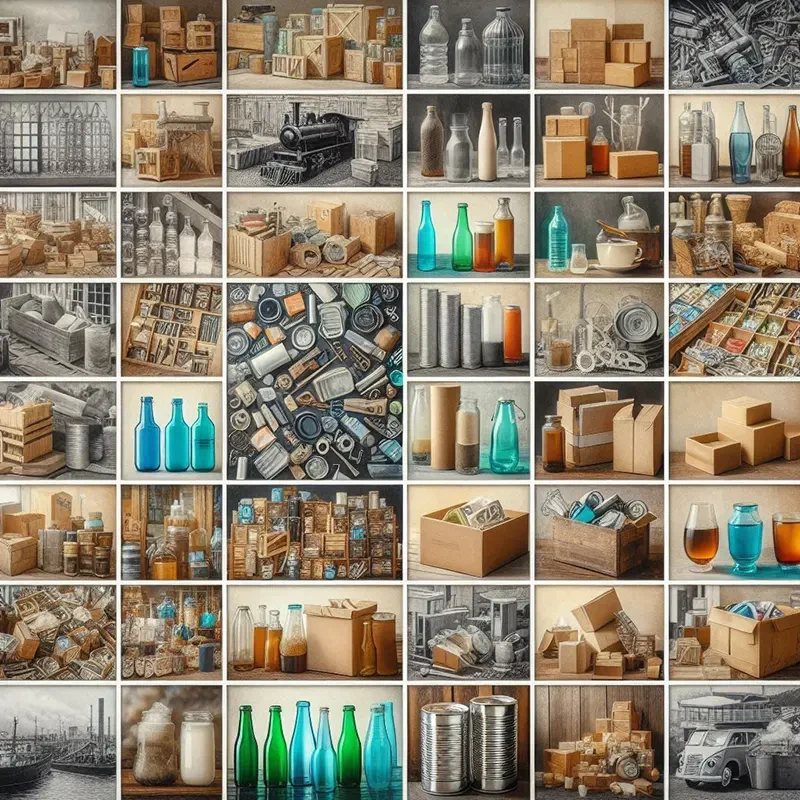Packaging has evolved alongside human history and plays a significant role in today's modern world. Used for transporting, storing, and protecting products, packaging has undergone a significant transformation over time due to changing needs, technological advancements, and environmental factors. So, how has the history of packaging unfolded? What key stages has packaging development passed through? Here’s a detailed review of the historical development of packaging.
The foundations of packaging date back to ancient times in human history. Early humans used natural materials to carry food and other items. These materials included stones, leaves, hides, crops, and clay. These first forms of packaging were primarily intended to protect the products, and they were generally quite simple. In ancient Egypt, portable containers, leather bags, and similar materials were used to protect food and other valuable items.
With the Industrial Revolution, packaging underwent a major transformation. In the late 18th century, industrial production rapidly increased, and mass production of goods necessitated stronger and more functional packaging. Now, packaging was not only about protection but also about ease of transportation and optimizing storage space.
During this period, packaging types such as metal cans, glass bottles, and paper bags became more common. These packaging products not only protected the items but also captured attention with their aesthetic appeal. With the Industrial Revolution, packaging evolved from being a mere practical tool to becoming an essential part of commerce and product marketing.
The 20th century saw one of the fastest evolutions in packaging. Especially after the 1920s, the discovery and widespread use of plastic materials revolutionized the packaging industry. Plastic, with its light weight, durability, and cost-effectiveness, made a significant impact in the packaging sector. Plastics used in packaging helped keep products fresh for longer and made transportation easier.
Additionally, during the 20th century, packaging design and brand recognition became more prominent. Packaging was no longer just a protective tool; it began to serve as a marketing instrument. Products were presented to consumers with aesthetic designs and colorful packaging, and thus, brands started promoting themselves.
In recent years, there has been an increasing awareness of the environmental impact of packaging. Issues like the depletion of natural resources and environmental pollution have driven the packaging sector to develop innovative solutions in sustainability and recycling. Since the early 21st century, there has been a growing focus on reducing plastic use, using recyclable materials, and developing biodegradable packaging types.
Recyclable packaging materials are increasingly preferred by environmentally conscious consumers, and brands are responding to this demand by offering green packaging solutions. Furthermore, the long-lasting presence of plastic packaging in nature has led to significant developments in bioplastics, which have become one of the most important innovations in the industry.
The future of packaging is being shaped by the possibilities provided by technology. Smart packaging technologies offer systems that enable products to be tracked and monitored. Components such as RFID tags, QR codes, and sensors allow for the tracking of products throughout the supply chain. These technologies not only enhance product safety but also improve the consumer experience.
Furthermore, emerging production methods like 3D printing are offering innovative solutions in the packaging industry. It is expected that in the future, packaging will be more functional, sustainable, and technologically advanced.
Packaging has played a crucial role at every stage of human history and continues to play this role today. Initially designed solely for product protection, packaging now serves critical functions in marketing, logistics, and environmental protection. With technological advancements and sustainability-focused innovations, the packaging industry is expected to continue offering more efficient, eco-friendly, and user-friendly solutions in the future.
Keywords: Packaging history, evolution of packaging, types of packaging, sustainable packaging, packaging design, eco-friendly packaging, smart packaging, packaging technology
